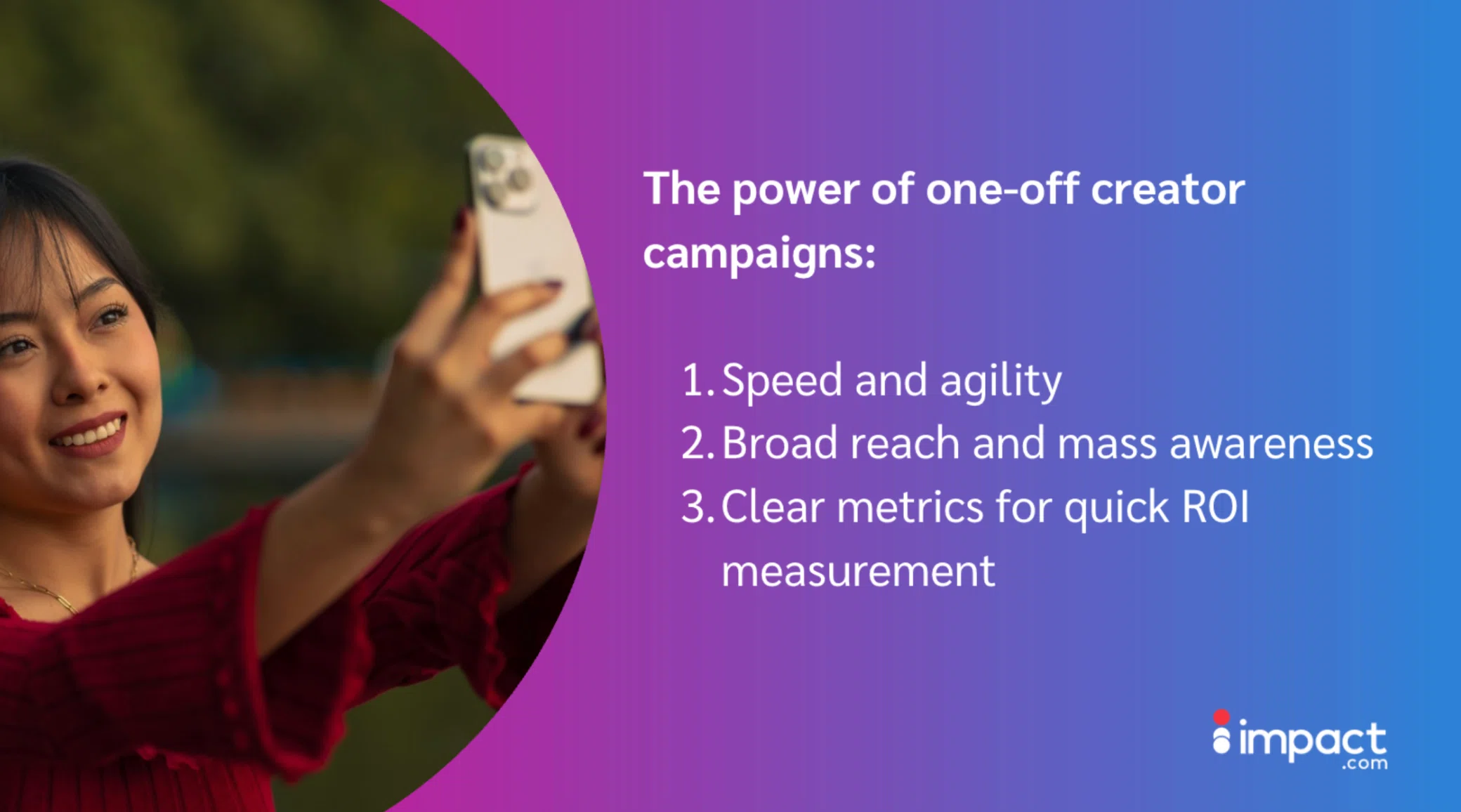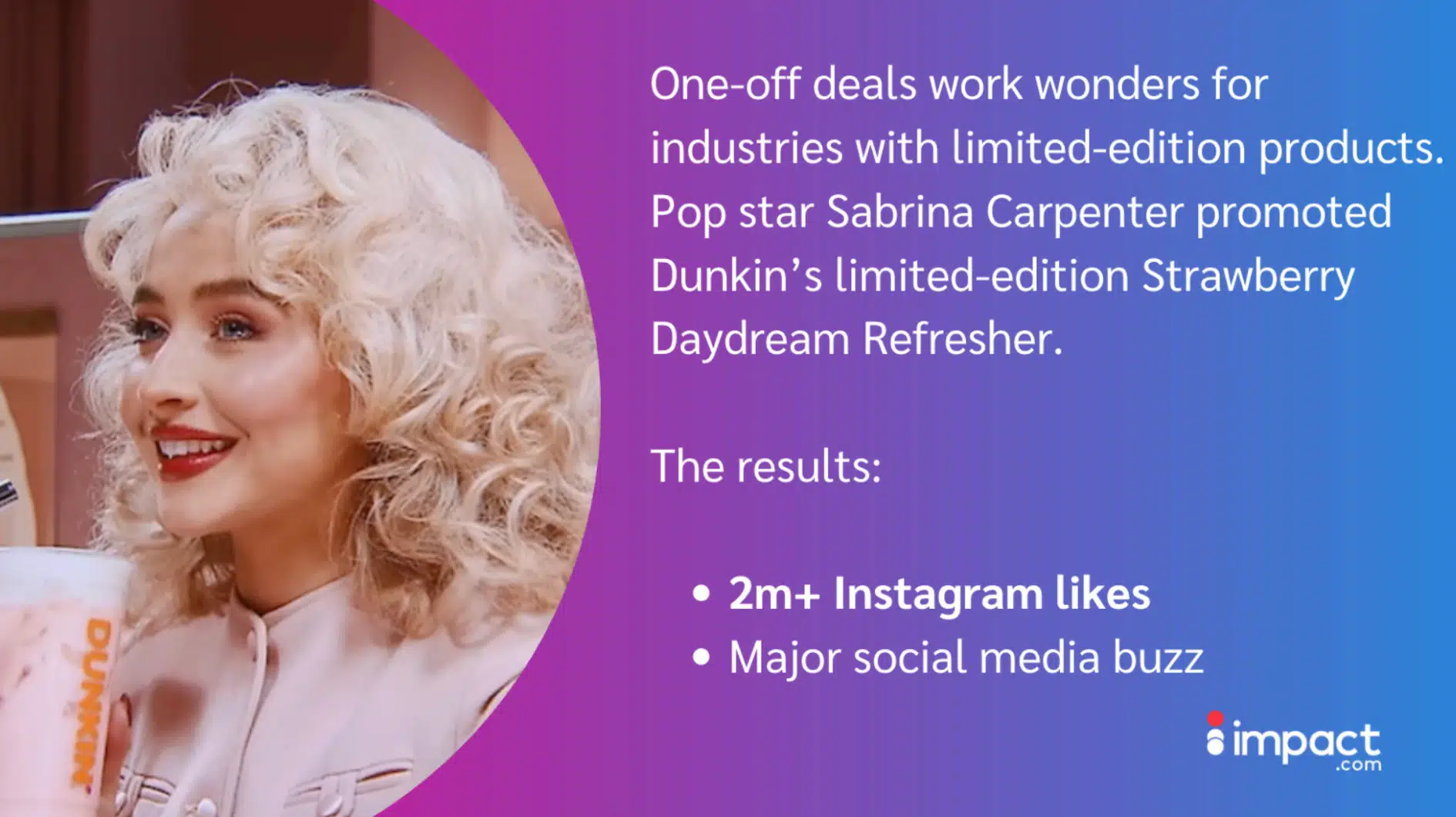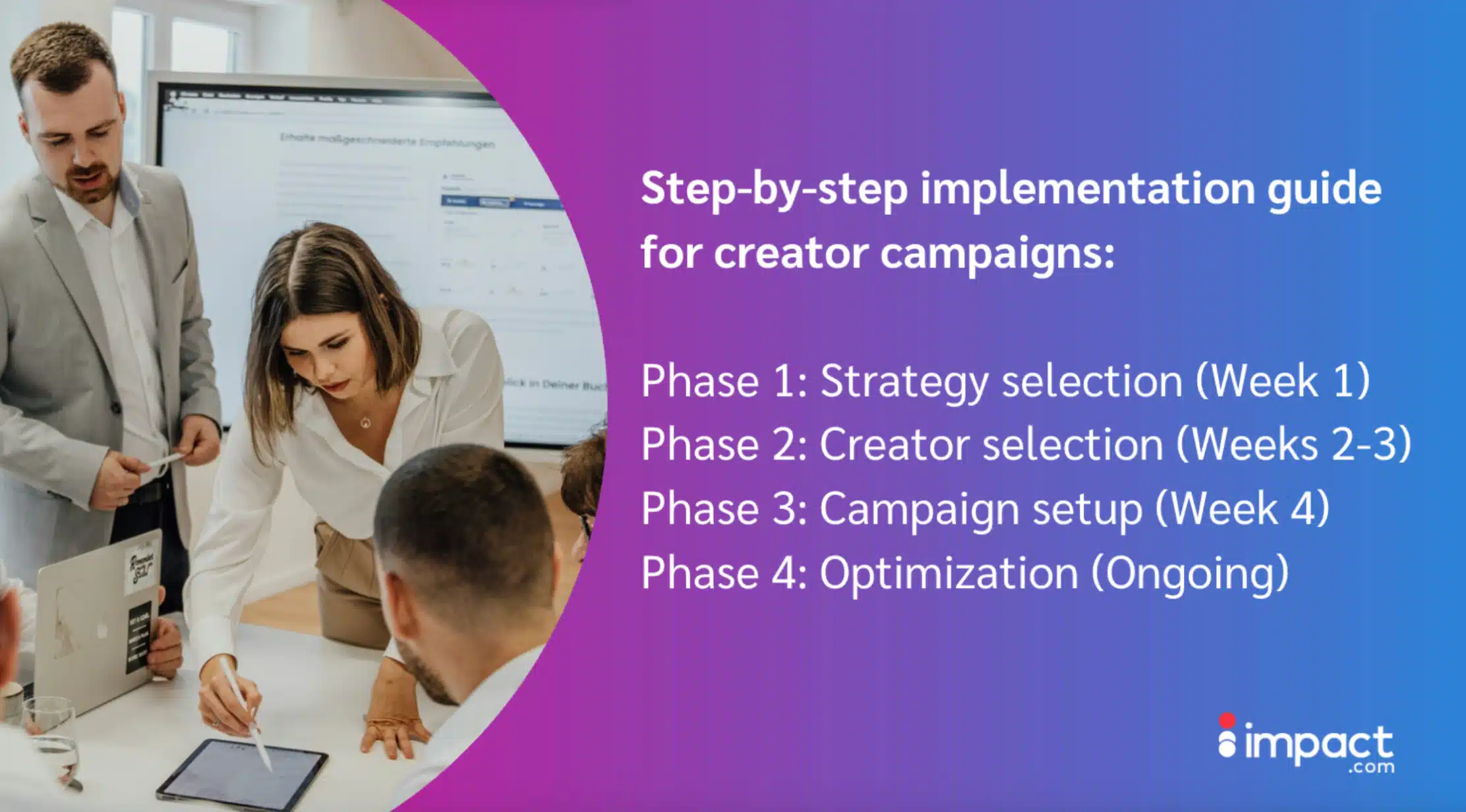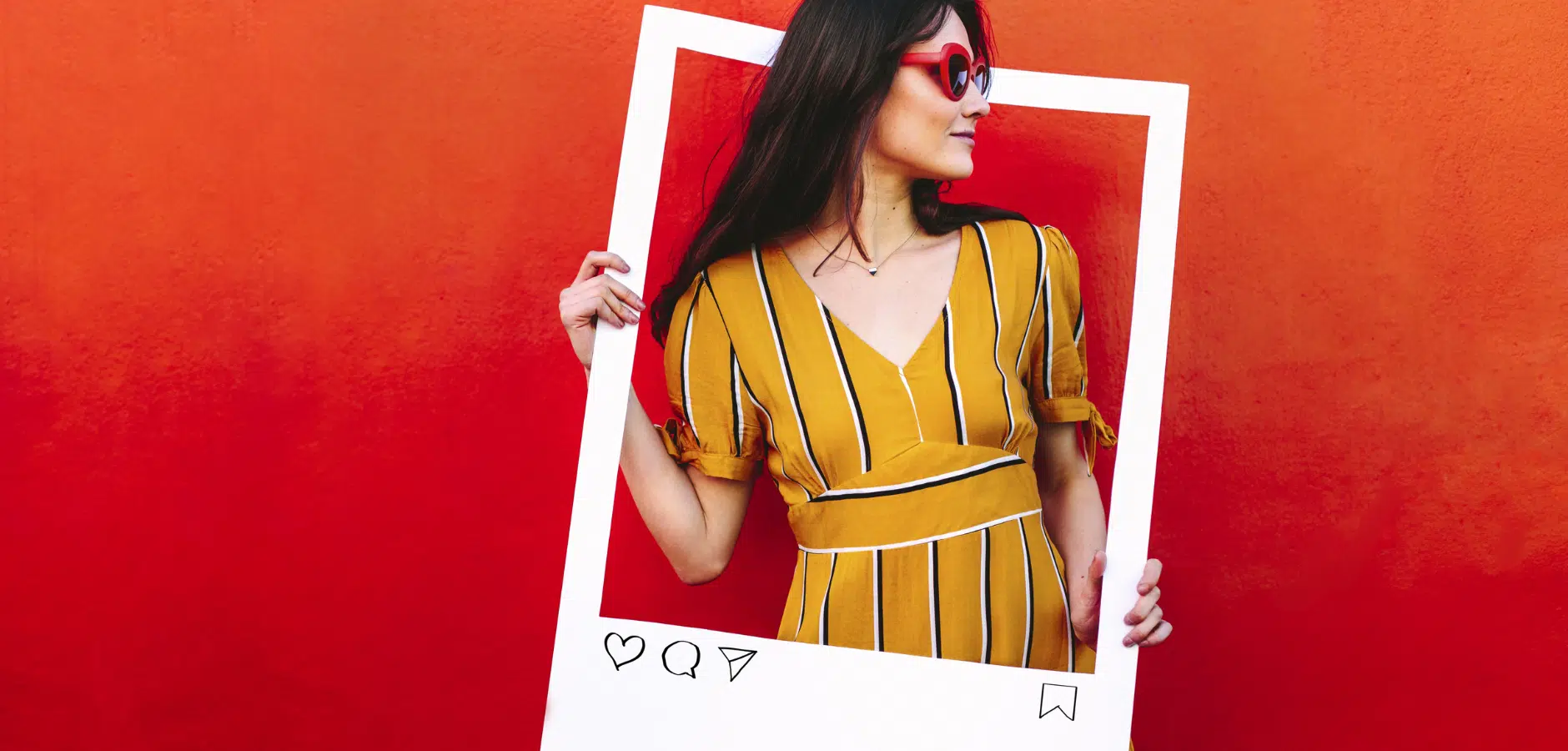A marketing manager faces a critical budget allocation decision: concentrate resources on high-impact, one-off campaigns with top-tier creators, or invest in sustained partnerships with multiple creators over time.
This choice directly impacts attribution tracking, cost per acquisition (CPA), and customer lifetime value (CLV)—the metrics that determine campaign success and future budget allocation.
Industry data increasingly supports the long-term approach: 63 percent of brands now prefer sustained collaborations over one-time engagements, with this figure growing yearly.
The benefits are clear:
- Higher CLV
- Better cost efficiency
- Predictable performance
- Greater return on investment (ROI)
- Building communities through authentic creator content
However, short-term collaborations can be the right call for marketers with tighter budgets and timelines.
In this blog, we’ll discuss:
- Why long-term partnerships deliver sustainable ROI
- A clear breakdown of short-term vs long-term strategy benefits
- When to choose the right strategy for your marketing goals
- Important metrics to consider
- Implementing your creator campaigns step by step

Understanding influencer marketing ROI
Influencers, both micro creators and larger personalities, have a unique ability to engage their audiences and build loyal communities across social media platforms.
For brands, tapping into these audiences can be a powerful way to achieve campaign goals while driving measurable results. When content creators deliver authentic product recommendations—supported with affiliate links, promo codes, or discount codes—the impact on engagement metrics, conversion rates, and campaign ROI is undeniable.
Before diving into influencer partnerships, however, it’s essential to understand the fundamentals of influencer marketing.
Discover how to measure campaign performance and assess the lasting impact of creator partnerships.
The ROI formula: What it is and how to use it
In influencer marketing, ROI measures the revenue generated compared to the total investment in creator partnerships.
Unlike surface-level engagement metrics, ROI reflects the broader business impact of working with content creators, from immediate sales to long-term brand awareness and customer loyalty.
The formula is simple:
ROI = (Revenue generated – campaign cost) / Campaign cost × 100
It’s important to recognize that ROI differs from ROAS (return on ad spend). ROAS focuses solely on ad dollars vs direct sales. ROI captures the full business value of influencer partnerships, like long-term brand lift, repeat purchases, and earned media.

Beyond ROI: A framework of key influencer marketing metrics
ROI is a critical benchmark, but it doesn’t tell the full story. To capture the complete impact of influencer marketing, brands should also track complementary performance and engagement metrics.
To fully grasp the impact of your influencer partnerships, consider tracking these metrics alongside ROI:
- Direct revenue metrics
- Engagement and reaction metrics
- Long-term brand metrics
Let’s break it down metric by metric.
Direct revenue metrics
Most influencer marketing partnerships’ primary goal is to increase revenue. These metrics highlight how these partnerships impact your bottom line.
Sales attribution
This includes promo codes, affiliate links, and UTM tracking to tie revenue lift directly to brand partners. It makes it easier to measure campaign ROI and compare performance across different creators.
Customer acquisition cost (CAC)
CAC measures the budget required to acquire a new customer. Lower CAC means more efficient growth. Long-term relationships with creators can help reduce CAC since their audiences already trust their recommendations.
Customer lifetime value (CLV)
CLV reflects the total revenue a customer generates over the lifetime of their relationship with your brand. Because creator-driven relationships are built on authenticity and trust, customers acquired through influencer marketing often have higher CLV, increasing the long-term ROI of influencer partnerships.
Average order value changes (AOV)
Many creators drive higher AOV by promoting product bundles, upgrades, or exclusive discount codes. These tactics increase immediate revenue and improve campaign performance.
Engagement metrics: Measuring audience reaction and resonating content
Certain metrics reveal how well an influencer’s content resonates with their audience. When evaluating branded content, track the following.
Engagement rates
Likes, comments, shares, and saves depict how much the audience interacts with a creator’s content. High engagement rates signal strong audience connection and content quality.
Reach and impressions
These metrics indicate audience scale and visibility, showing how many people were exposed to branded content.
Brand mentions sentiment
Monitoring how an audience speaks about your brand after seeing influencer content helps assess brand perception, whether positive, neutral, or negative.
Share of voice
This metric indicates how often your brand is surfaced in the creator economy compared to competitors. It’s helpful for providing context for overall brand awareness within your industry.
Long-term brand metrics: Tracking awareness and trust
One of the most valuable benefits of influencer marketing is brand awareness. These metrics help determine if your brand is becoming recognizable and trusted over time:
Brand awareness lift
Compare baseline brand awareness with current results to measure how influencer partnerships contribute to greater brand visibility.
Brand consideration changes
Brand consideration changes, tracked through surveys and brand mentions, reveal whether customers are progressing toward making a purchase.
Website traffic and time-on-site
Creator traffic often increases time-on-site and website traffic, thanks to the built-in trust of influencer recommendations.
Email and social follower growth
Each creator partnership helps expand your audience across social media platforms and email lists, lowering CAC over time and boosting CLV and AOV.
Attribution challenges and solutions
Measuring ROI in influencer marketing isn’t always straightforward. Multi-touch attribution, organic discovery, and brand awareness lift can complicate the picture.
Customers may see a creator’s content on social media, click an affiliate link, search for your brand later, and then return with a discount code before purchasing. These multiple touchpoints make it difficult to capture the full impact of influencer partnerships.
Tools like impact.com help simplify the process. Advanced tracking technology goes beyond simple clicks and views to provide a clear view of campaign performance:
- Direct attribution: Unique tracking links and promo codes tie sales directly to creators.
- Comprehensive data: Real-time analytics measure clicks, conversions, revenue, and other essential metrics.
- Cross-device and cookieless tracking: Privacy-compliant tracking captures delayed conversions across devices, ensuring coverage of the entire buyer’s journey.
These capabilities help brands understand the true value of influencer marketing campaigns and optimize future partnerships with confidence.
Timeline considerations: Immediate vs delayed returns
ROI measurement often depends on the type of campaign and the customer journey involved.
| Campaign type | Key characteristics | Impact on ROI |
| One-off creator campaigns | Designed to drive immediate sales impact. | Short-term ROI is easier to calculate. |
| Long-term creator partnerships | Require extended measurement windows. Benefits include improved conversions, engagement, and sustained brand awareness. | Gradual ROI growth as long-term benefits build. |
| Seasonal and cyclical campaigns (e.g., Christmas) | Influenced by product launches or holidays, leading to spikes in buying behavior. | ROI fluctuates with seasonal or cyclical demand, creating noticeable spikes |
For the most accurate view of campaign performance, brands should track CAC and CLV over a 6–12 month window.
Long-term tracking provides a complete overview, ensuring ROI reflects immediate conversions and the long-term value of influencer partnerships.
Why sustained creator partnerships deliver superior ROI
One-off influencer marketing campaigns can deliver strong short-term results, but they don’t always sustain the momentum.
By contrast, building long-term relationships with trusted content creators keeps your brand top of mind across social media platforms. This repeated exposure boosts conversion rates and fosters a more loyal customer base.
Let’s look into why long-term creator partnerships often deliver stronger campaign ROI for brands.

Building genuine trust and authenticity
Authenticity is the heart of influencer marketing. The more authentic a creator appears, the more their audience trusts their recommendations. 64 percent of consumers repeatedly buy products based on influencer recommendations. This makes it crucial for brands to invest in authentic creators.
Long-term relationships amplify this effect. Repeat recommendations often drive higher conversions and increase loyalty more effectively compared to a casual one-off mention.
A one-time post of a beautiful Instagram Reel isn’t going to drive conversions, as noted by Caroline Hindman, Senior Manager of Creator Services at impact.com. It takes multiple posts across the customer journey to reach a purchase decision. A budget-friendly way to do this? Recruit nano- and micro-creators who excel at content creation. They deliver high-quality results at a fraction of the cost of large-scale influencers.
Psychology also comes into play here. The “mere-exposure effect” reveals that the more we see something, the more we tend to like it. When a creator genuinely incorporates a brand into their content, it feels natural. It’s less like a sales pitch and more like a recommendation from a friend. This builds trust and loyalty over time.
Long-term partnerships in action: Arun Maini + Samsung
YouTuber Arun Maini, aka Mrwhosetheboss, shows how powerful long-term creator partnerships can be in the tech world. He’s built a solid relationship with Samsung over the years, becoming a trusted and authentic voice for the brand.
Maini’s ability to deliver honest, in-depth reviews helps him truly connect with his viewers. By staying transparent and focusing on quality content, he’s earned credibility as a genuine advocate for Samsung, helping bridge the gap between the brand and consumers.
Partnerships like this are proof that trust, consistency, and shared values can create staying power. They build brand loyalty while letting creators stay true to themselves.

Achieving cost efficiency and predictable performance
One-off mentions from larger creators can be costly, and the ROI isn’t always predictable. Long-term influencer partnerships, however, often allow brands to negotiate better rates and lock in more cost-effective agreements.
These sustained collaborations operate on streamlined workflows, providing steady, reliable data that makes tracking easier.
This approach offers a sustainable and predictable business model for creators and brands alike. Jasmine Enberg, VP & Principal Analyst at eMarketer, highlights that “creators benefit from a steady income, while brands can plan their budgets effectively over longer periods.” With both sides satisfied, the result is ultimately stronger, better-performing campaigns.
Reliable data from ongoing content creation helps brands:
- Refine strategies to better connect with target audiences
- Reduce cost per acquisition (CPA)
- Lower campaign risks
- Avoid costly creative resets or repetitive negotiations
Unlocking customer lifetime value (CLV)
A customer journey is rarely linear. Most shoppers research, compare options, and revisit a brand before buying. Strategic long-term creator relationships play a major role in the customer journey. They start by generating brand awareness and then guiding purchases using:
- Trusted recommendations
- Affiliate links
- Exclusive discount codes
Creators who consistently feature a brand double as true advocates. By organically weaving the brand throughout their content, they help inspire repeat purchases and encourage user-generated content (UGC) from their communities.
87 percent of Gen Zs say they’ll buy based on an influencer’s recommendation. When authentic audience content and honest reviews act as social proof, it encourages action from other community members.
This sustained influence strengthens customer lifetime value, making long-term relationships with creators a key driver of lasting ROI.
Long-term partnerships in action: Yamazaki Home + impact.com + JEBCommerce
Situation
Yamazaki Home, a Japanese brand known for its thoughtfully designed home goods, found itself with an affiliate program that was anything but innovative. Recognizing the need for a complete overhaul, Yamazaki Home partnered with the affiliate agency JEBCommerce and leveraged impact.com‘s technology.
Solution
This partnership was a strategic shift, focusing on building long-term relationships that authentically reflected the brand’s sophisticated, minimalist aesthetic.
Here’s what they did:
- Reactivated high-performing partners: JEBCommerce used its database to identify successful partners who had gone inactive.
- Launched targeted campaigns: They re-engaged these proven performers with refreshed content, exclusive promo codes, and enhanced commission structures.
- Protected high-value partners: Using impact.com’s customer journey mapping, they discovered and prevented attribution theft from last-click partners, ensuring that valuable content creators received proper credit for their influence.
Outcome
This strategic investment in long-term partnerships delivered results that exceeded all expectations within six months.
- Revenue increased 576 percent
- Orders rose 340 percent
- Conversion rates grew 395 percent
- The channel maintained an impressive 15:1 ROI
By focusing on authentic, long-term relationships, Yamazaki Home transformed a stagnant program into a high-performing, sustainable growth channel. This case illustrates how sustained creator partnerships can maximize ROI and turn partners into true brand advocates.

When a quick win is the right call: The power of one-off campaigns
Although long-term partnerships are often more effective, one-off campaigns can be powerful.
Here’s when to consider launching a one-off campaign.

Speed and agility for specific goals
Long-term campaigns deliver lasting impact, but they require time, planning, and strategic relationship building. For marketers who need quick wins, one-off campaigns can be effective when paired with the right creators.
Short-term initiatives work best for:
- Product launches
- Seasonal sales
- Event-based marketing
These campaigns help brands test new audiences without long-term engagements.
One-off campaigns also create valuable opportunities for A/B testing, helping marketers evaluate campaign performance, content quality, and audience fit before scaling into larger investments.
One-off campaigns in action: Dunkin’ + Sabrina Carpenter
One-off deals work wonders for industries with limited-edition products. A standout example? The partnership between Dunkin’ and pop star Sabrina Carpenter to promote the limited-edition Strawberry Daydream Refresher.
The concept
- The campaign featured a retro-style short film starring Carpenter as a hotline matchmaker, prescribing the drink as the ultimate summer escape.
- This fun and playful approach gave the campaign a bold personality, grabbing attention and standing out from the crowd.
The results?
- Two million likes on Instagram (and counting)
- Major social media buzz
- Tapped into Carpenter’s loyal fan base

Broad reach and mass awareness
When brands partner with top-tier creators, one-off campaigns can also deliver explosive reach. A well-executed one-off campaign can generate millions of impressions and earn media coverage far beyond the brand or creator’s direct audience.
For new brands that need a large-scale introduction, these partnerships provide a powerful platform to build brand awareness on social media. They help place brands directly in front of engaged audiences that may otherwise be challenging to reach.
It’s also important to note that campaign goals and engagement rates often vary by industry vertical. Brianna Doe, Founder & CEO at Verbatim, explains, “B2B brands often request longer-term partnerships, usually lasting three to six months to cover their sales cycles, while B2C requests are shorter.”
One-off campaigns in action: New Balance + Jack Harlow + Endrick
New Balance, known for its cool celebrity endorsements, relaunched the classic T500 tennis shoe with a campaign featuring rapper Jack Harlow and Brazilian football star Endrick.
This collaboration, a lesson in cross-cultural marketing, combined Harlow’s influence in music and fashion with Endrick’s athletic talent and rising fame. The limited-edition drop connected the brand with two massive audiences who were eager to make a purchase.

Clear metrics for quick ROI measurement
One-off campaigns typically focus on immediate ROI. Because the results are tied to specific actions, these campaigns are straightforward to measure and useful for testing creators before committing to long-term engagements.
In these partnerships, campaign goals and key performance indicators (KPIs) are clear and measurable:
- Sign-ups
- Coupon code redemptions
- Single-day website traffic spikes
This focus on direct engagement metrics makes campaign ROI easier to calculate and compare against the more complex, brand-building outcomes of long-term influencer partnerships.
Consider this: Short-term creator partnerships can also become long-term
Smart brands recognize the value of short-term and long-term partnerships.
A successful one-off campaign can signal the beginning of a long-term working relationship. Major brands are catching on: Brittny Kindred, Sr. Manager of Affiliate and Influencer Marketing at The Home Depot, explains, “We tend to move creators who perform well on shorter-term campaigns into longer-term partnerships.”
The lesson: Short-term campaigns can serve as a testing ground, helping identify top performers who can evolve into trusted brand ambassadors and long-term growth partners.

Choosing compensation models for long-term creators vs one-off partnerships
For influencer marketing campaigns to succeed, brands must fairly compensate creators for the time, effort, and content creation required to drive results.
Compensation models vary depending on the type of engagement, campaign goals, and whether the partnership is a one-off collaboration or a long-term relationship.
Typically, this is how it could look:
- One-off campaigns: Flat fees
- Long-term partnerships: Hybrid compensation
Let’s take a closer look at the two.
One-off campaigns: Clear and predictable flat-fee pricing
One-off campaigns most commonly use flat fees per post, with rates varying by creator size and niche.
While simple, this model should fairly reflect the effort involved. Content creation, strategic alignment, and active audience engagement require significant time and skills.
Marie Montano, Senior Manager of Creator Relations at impact.com, cautions against offering less than $500 per post, given the workload.
Brand benefits: Predictable and manageable campaign costs with a simple flat fee.
Creator benefits: Guaranteed income through a transparent and straightforward payment structure.
For long-term partnerships: The power of hybrid models
Long-term partnerships typically benefit from more sophisticated compensation structures. Hybrid models blend a base fee with performance incentives. Creators prefer this method for long-term partnerships and find it motivating to hit clear targets like sales volume or engagement.
As Montano explains: “A viral video with an affiliate link can provide a long-term play with way more money than you could have gotten from the flat fee.” She also recommends pairing flat fees with competitive commission rates of 10 percent or more to gain a competitive edge.
Brand benefits: Scalable, performance-driven partnerships that generate consistent revenue.
Creator benefits: Hybrid models offer lucrative earning opportunities.
Long-term creator partnerships vs one-off campaigns: A direct comparison
| Feature | Long-term creator relationships | One-off campaigns |
| Primary goal | Sustained growth, brand advocacy, and community building. | Short-term sales, product launches, and event promotion. |
| Cost and investment | Higher initial investment but lower CPA over time | Lower initial cost, but higher per-campaign cost. |
| ROI measurement | Focus on CLV, brand sentiment, and sustained growth. | Focus on immediate sales, conversion rates, and campaign-specific engagement. |
| Authenticity | High. Creators become genuine brand advocates, integrating products naturally. | Lower. It can feel more like a sponsored ad if not integrated seamlessly. |
| Audience impact | Builds deep trust and loyalty within a creator’s core community. | Generates a wide reach and a quick spike in awareness. |
| Compensation type | Often, a hybrid model (flat fee + commission) is used to incentivize ongoing performance. | Typically, a flat fee for a single piece of content. |
| Risk and flexibility | A higher upfront commitment, with a lower campaign-to-campaign risk due to established trust, proven performance, and a foundation of shared data. | Low commitment and high agility, allowing brands to quickly pivot strategies. |
Marketers’ guide: How and when to implement your influencer marketing campaigns
Brands can maximize influencer marketing by using both short-term and long-term campaigns. Each type serves different goals and works best in different situations.
Here’s how each type can benefit your brand:
Short-term campaigns
- Ideal for quick wins
- Generate buzz and immediate engagement
- Expand your audience quickly
- Can lead to long-term relationships with top-performing creators
Long-term partnerships
- Focused on consistency and sustained results
- Provide ongoing performance data to identify high-value touchpoints in the customer journey
- Boost revenue, conversion rates, and brand awareness over time
Ultimately, whether you go short-term, long-term, or both, the key is matching your campaign to your goals and making the most of your influencer relationships.
Now that you’re familiar with the benefits, let’s explore the best scenarios for choosing each strategy.
Decision matrix: when to choose each strategy
Here’s how to choose which creator partnership strategy works best for your brand and goals.
| Long-term campaign triggers | |
|---|---|
| Use case | Description |
| New brand or product launches | Product launches thrive with mentions across text posts, videos, and other content types. Repeated creator recommendations boost brand awareness and encourage audiences to engage and explore your brand. |
| Complex product education | Long-term creator partnerships are valuable for educating customers about complex features. By explaining products on social media, creators boost adoption and drive conversions. |
| B2B with long sales cycles | B2B decision-makers spend a lot of time researching. Partnering with trusted industry creators keeps your brand visible throughout the customer journey, boosting credibility and campaign performance. |
| Strong lifestyle and community focus | For lifestyle or community-focused brands, creators serve as natural ambassadors. By leveraging audience trust, brands can build loyalty and attract high-value customers. |
| Budgeting for 6+ months | Long-term partnerships take time and money. When built on performance and authenticity, they deliver growing returns and boost campaign ROI over time. |
| One-off campaign triggers | |
|---|---|
| Situation | Benefits |
| Tight-timeline product launches | Launching a product under time pressure? One-off campaigns with top creators work well. Instead of spreading mentions across the customer journey, brands can put the product directly in front of a ready-to-buy audience. |
| Market tests | One-off campaigns offer quick, real-time data on market viability and receptiveness—without a long-term commitment. |
| Event-based campaigns | These campaigns work well with holiday sales, seasonal promotions, or limited-time events. |
| Limited campaign budgets | For brands with tight budgets, one-off campaigns can quickly boost reach and engagement on social media. |
While one-off campaigns offer speed and flexibility, and long-term relationships deliver sustainability and loyalty, the most effective influencer marketing strategies often blend both approaches. With the right mix, brands can meet immediate campaign goals while laying the foundation for sustainable growth.
Step-by-step implementation guide
Follow this step-by-step implementation guide to get the most from your influencer partnerships and maximize your ROI across campaigns.

Phase 1: Strategy selection (Week 1)
Depending on your vision, long-term partnerships might serve you better than one-off campaigns—or vice versa. Choose the right strategy by:
Auditing your goals and timelines
Decide whether immediate ROI or long-term growth is the priority. Mapping out your campaign goals and timelines will clarify whether short-term creator collaborations or long-term relationships are the best fit.
Assessing budgets
Long-term influencer partnerships require sustained investment over several months. Short-term campaigns can be more cost-effective. Remember that top-tier creators may cost more upfront compared to a long-term commitment.
Defining your success metrics
Establish KPIs before launching. Metrics such as engagement rates, conversion rates, or campaign ROI will help measure the success of your influencer partnerships.
Drafting campaign briefs
A detailed campaign brief sets the foundation for campaign performance. Outline partnership type, duration, budget, campaign goals, and content creation expectations to align both brand and creator from the start.
Phase 2: Creator selection (Weeks 2-3)
With a detailed campaign brief, identify which creators and influencers are best suited for your campaign. Evaluate and engage them by:
Make a creator vetting checklist
Consider questions such as:
- Is the creator’s engagement genuine, or does it appear inflated?
- Does their content feel authentic and relatable to their audience?
- Does their audience align with your ideal customer profile?
- Is the creator’s content high quality?
- Does the creator align with your brand’s standards?
Pay close attention to authenticity, alignment, and quality to establish the best partnerships.
Outreach templates for creator engagement
If your campaign engages with multiple creators or audiences, prepare an outreach template. Use it to clearly explain your initiatives, expectations, and compensation models, so creators understand how campaign performance will be measured.
Guidelines for negotiation
Establish guidelines in advance. This ensures fair discussions, gives creators space to negotiate rates that meet their income goals, and creates transparency in the partnership.
Contract templates
Contracts protect both your brand and the creators. They outline compensation models, payment timelines, and campaign deliverables, while also reducing risk and strengthening long-term relationships.
Phase 3: Campaign setup (Week 4)
Once your partnerships are in place, it’s time to launch your campaign. To establish key steps, refer to the campaign brief.
Content briefs to ensure brand alignment
Provide creators with clear strategic guidance to ensure creator content aligns with campaign goals. Without a detailed brief, you risk confusion or off-brand messaging.
Approval workflows
Establish an approval process before content goes live. This ensures every piece of content creation reflects your brand voice, maintains consistency, and reinforces positive brand awareness.
Tracking setup
Implement UTMs, promo codes, and affiliate links to track each creator’s contribution to conversions and sales. Proper tracking ensures creators are compensated fairly and spotlights which partners are top performers, helping optimize campaign ROI.
Communication schedules
Successful partnerships thrive on consistent communication. Establish regular check-ins to keep your team and creators aligned on deliverables, campaign performance, and evolving engagement metrics.
Phase 4: Optimization (Ongoing)
As performance data rolls in, use it to adjust your campaigns.
Monitor performance checkpoints
Establish realistic benchmarks and compare them to real-time results. This helps evaluate the effectiveness of your creator partnerships against campaign goals.
Analyze content results
Track engagement metrics such as engagement rates, likes, comments, and shares to assess content quality and resonance. Use these insights to adjust campaign performance in real time.
Nurture long-term relationships
Strong influencer partnerships thrive when brands invest in relationship-building. When creators feel valued, they’re more likely to evolve into authentic brand ambassadors—often advocating for your brand even in non-sponsored content.
Pivot underperforming campaigns
If a creator partnership isn’t delivering, don’t be afraid to end the engagement early. This approach saves time and budget, while giving both brand and creator the freedom to pursue partnerships that are better fit.
FAQs
Long-term partnerships foster genuine trust and authenticity by repeatedly exposing audiences to a brand, which drives higher conversion rates and lasting loyalty. They’re also more cost-efficient—brands often secure better rates and avoid repetitive negotiations. Over time, the consistency of these collaborations enables more accurate forecasting and optimization, reducing campaign risks and improving overall performance.
By building genuine trust and authenticity over time, long-term partnerships maximize ROI through higher conversion rates and stronger customer loyalty. A creator’s endorsement shifts from a one-off recommendation to an authentic, recurring part of their content. This consistency deepens audience trust and lowers cost per acquisition (CPA), as established workflows and ongoing data streams make campaigns easier to optimize.
When choosing between strategies, brands should start with their goals. One-off campaigns work best for time-sensitive objectives, such as product launches, seasonal promotions, or market testing. Long-term partnerships, on the other hand, are ideal for sustained growth, deeper customer relationships, and building lasting brand advocacy.
Long-term partnerships are especially effective at building loyalty and driving higher conversion rates. With repeated, natural exposure to a brand, audiences develop trust that extends beyond a single purchase, fueling repeat sales and turning followers into vocal brand advocates.
One-off campaigns are ideal for time-sensitive goals, such as product launches or seasonal promotions. They create a powerful, short-term surge in brand awareness and are often essential for introducing new products at scale. Importantly, they can also serve as a stepping stone for high-performing creators who want to transition into long-term partnerships that deliver sustained value.
To maximize ROI, brands should adopt hybrid compensation structures for long-term partnerships—blending a fixed base rate with performance-based incentives. This model aligns the creator’s success with the brand’s, encouraging deeper commitment and stronger results.
Blending short and long-term partnerships: The smarter path to influencer ROI
The most effective marketing strategies leverage a mix of one-off campaigns and long-term creator partnerships. Use one-off campaigns for quick wins and to test new audiences. Then transition top-performing creators into long-term partnerships. This approach allows you to achieve immediate goals while building the foundation for sustainable growth.
For quick wins:
- Use one-off campaigns for time-sensitive goals like product launches, seasonal promotions, or market testing.
- These campaigns create a powerful, short-term surge in brand awareness and are ideal for introducing new products at scale.
- One-off campaigns also provide valuable, real-time data on market viability and offer high agility for brands to quickly pivot strategies.
For lasting ROI:
- Invest in long-term relationships to build genuine trust, loyalty, and brand advocacy.
- These partnerships lead to more predictable performance, lower CAC, and higher CLV over time.
- Brands should also use a hybrid compensation model that combines a base fee with performance incentives to motivate creators and align their success with the brand’s goals.
Check out more content here:
- Moving beyond awareness: How creators drive conversions through social commerce and affiliate programs [blog]
- 2025 mid-year consumer shopping insights: How extended purchase journeys are reshaping retail partnerships [research]
- BARK Case Study: How Strategic Affiliate Program Segmentation Boosted Pet Brand Partnership ROI
- Evaluating influencer performance in 2025: 3 ways brands can optimize ROI through real-time tracking [blog]
- The Partnership Economy Podcast: Smarter partnerships with smaller creators
- Multi-platform creator partnerships: Monetization strategies that drive ROI across social channels [blog]







